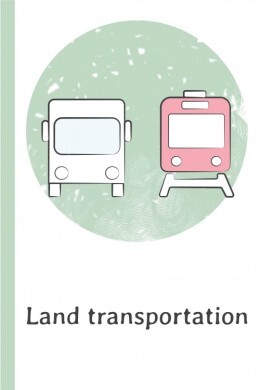a steel track on which trains run

レール, 線路
a pair of metal bars that trains use to move

線路, レール
a set of tracks that trains travel on between destinations

鉄道線, 線路
an important railroad line between two cities or large towns

本線, 主要線
a secondary railway line that splits from a main line

支線, 分岐線
a short track connected to a main track, used for loading, unloading, or storing trains

側線, サービス線
a short railway track branching off from a main line, typically leading to a specific facility

支線, 連絡線
the layer of crushed stones or gravel placed under and around railway tracks to keep them in place and provide drainage

軌道バラスト, 鉄道バラスト
a railway system that has only one rail instead of two, usually in an elevated position

モノレール, 単軌鉄道
a mechanical installation enabling trains to be guided from one track to another

分岐器, 転轍機
a type of railway powered by cables that goes up and down a slope

ケーブルカー, 索道
an additional rail providing electric power to trains, often used in subway systems

第三軌条, 電力を供給する追加のレール
a wire or cable that is used to carry electricity or signals and is supported above the ground by poles or towers

架空線, 架空ケーブル
a crosspiece used to hold the rails in place and keep them evenly spaced

枕木, レールを固定するための横木
the farthest point reached by a railway line or the starting point for transport of goods

鉄道の終点, 鉄道ターミナル
the layer of stones or other material on which the railway tracks are laid

軌道床, 路盤
a flat piece of metal used to join and support the ends of rails in a railroad track

締結板, レール接続板
the distance between the inner sides of the two parallel rails of a track

軌間, 線路幅
a smaller distance between railroad tracks, less than the standard size, often used in mountains or small space

狭軌, ナローゲージ
the most common distance between railroad tracks, which is 1,435 mm apart

標準軌, 標準軌間
a place where trains regularly stop for passengers to get on and off

駅, 鉄道駅
a place where trains stop to pick up or drop off passengers and cargo

鉄道駅, 駅
the raised surface in a station next to a railroad track where people can get on and off a train

プラットフォーム, ホーム
a large open space or hallway within a building, often used for gatherings or as a central area in transportation hubs like airports or train stations

コンコース, メインホール
a building or structure from which railway signals and switches are controlled

信号箱, 操作室
a new train or bus station built on an existing line to serve an area that previously did not have a nearby station

インフィルステーション, 中間駅
a major station where multiple train routes converge and services are provided

主要駅, 鉄道ターミナル
a raised structure in a train station where passengers can board and alight from trains, surrounded by tracks on both sides

島式ホーム, 中央プラットフォーム
a type of railroad where trains rely on friction between the wheels and the track for propulsion rather than using a cog or rack system

粘着鉄道, 接着鉄道
a railway with a toothed rail, allowing trains to operate on steep gradients

歯車式鉄道, ラック式鉄道
a complex of tracks where trains are stored, maintained, and built

操車場, 分類駅
a specialized railway facility where freight trains are sorted into different tracks according to their destinations or routes

分類ヤード, 操車場
a circular railway track that allows trains to change direction without needing to turn around

バルーンループ, 転車台線路
a track arrangement where three rails converge to allow trains to change direction

転車台三角形, 線路の星
the cross-sectional shape or contour of a railway track's metal rail

レールプロファイル, 線路の断面形状
a term used to describe any equipment, device, or structure used on or alongside railway tracks to facilitate safe and efficient operations

線路物体, 鉄道設備
a tall structure supporting electrical wires used to power trains

牽引電流鉄塔, 架線柱
| 陸上交通 |
|---|
